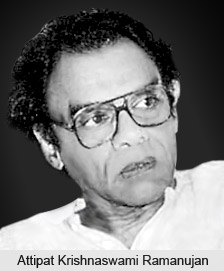 Attipat Krishnaswami Ramanujan had equal expertise in both English and Kannada. He was considered an expert in Indian literature. Ramanujan was born in the city of Mysore to an Iyengar family in the year 1929. He received his education in the University of Mysore and the Indiana University. As a writer Ramanujan had the experience of both the native as well as the foreign milieu and as a result he was able to incorporate the cultures and conventions of both the east and the west.
Attipat Krishnaswami Ramanujan had equal expertise in both English and Kannada. He was considered an expert in Indian literature. Ramanujan was born in the city of Mysore to an Iyengar family in the year 1929. He received his education in the University of Mysore and the Indiana University. As a writer Ramanujan had the experience of both the native as well as the foreign milieu and as a result he was able to incorporate the cultures and conventions of both the east and the west.
Ramanujan`s poetry seemed to grow out of Indian experience and sensibility with all its memories of family, local places, images, beliefs and history. At the same time his writings included a modern stance with its scepticism, ironies and sense of living from moment to moment in an ever changing world in which older values and beliefs are often considered as unrealistic. Ramanujan through his writing could evoke the warmth of traditional family life and closeness of long remembered relationships. More often he showed conflicts, arguments and surprises. He also showed that the supposed glory of Tamil cultural heritage is a fiction which ignored the reality of the past.
It can be said that Ramanujan`s memory are located in the specific society of the Tamil Brahmins. His poems avoided vague generalizations about India and were set in particular situations or scenes or developed from reflections on specific topics. Nor did his poem contain a fixed attitude or stance which the poems set out to communicate rather the poems changed direction and seemed unpredictable as they developed with the ending often different from the values implied at the beginning of a poem.
The sophistication with which Ramanujan recreated and treated South Indian culture was also reflected in his techniques which like his translation often seemed a modern recreation of the spirit and methods of Tamil and Kannada verse.
The word play, puns, inner rhymes, rhetorical devices, ironies, distanced neutrality of tones, understatement, compression and elliptical progression of the poems had similarities to his translations. This does not mean that Ramanujan was not affected by the reading of Yeats and other contemporary writers but as a writer he was highly aware of the conventions, techniques and structures of Indian verse and these had been used and transformed in his English poetry.
The complexity, instability and irony of Ramanujan`s poems seemed very modern as was the way they appeared to offer themselves as imagistic statements to be appreciated and interpreted as the reader wishes. But one gets introduced with various introductions, prefaces and afterwords to Ramanujan`s translation of medieval Kannada and Tamil verse revealed that what seems to be original and modern is partly based on older Indian poetic conventions. The understated, neutral standing at a distance from descriptions can be found in the Tamil classics which he had translated. The use of the self as a centre for a poem filled with ironies which unpredictably changeed directions and attitudes and which resisted conclusion is within the tradition of medieval saint`s poetry
Major Works of Ramanujan
Some of the well known works of Ramanujan in the field of poetry are vast. His poems vividly depicted the modern style and some of the popular poems are The Striders published in the year 1966, Interior Landscapes: Love Poems from a Classical Tamil Anthology in 1967, Relations published in 1971, Selected Poems of 1976, Hymns for the Drowning in 1981, Poems of Love and War published in the year 1985 and a lot more.
AK Ramanujan a shinning personality in the realm of modern Indian English poems had passed away in the year 1939 due to a reaction to anaesthesia which was applied to him during an operation.













